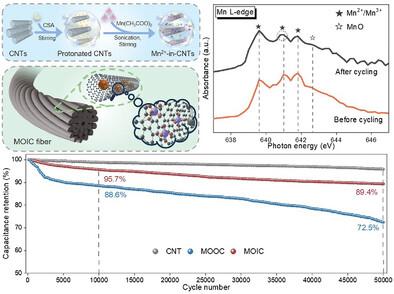Nanoconfined and Chemically Bonded MnO@Mn2O3 Heterojunctions Within Carbon Nanotubes for Fibrous Supercapacitor with Ultra-Long Cycle Stability
IF 18.5
1区 材料科学
Q1 CHEMISTRY, MULTIDISCIPLINARY
引用次数: 0
Abstract
Carbon-based fibrous supercapacitors (FSSCs) are promising power sources for wearable electronics, often compounding with transition metal oxides (TMOs) to improve energy density. However, conventional methods introducing TMOs onto exterior surfaces of carbon-based fibers typically degrade electrical transport and cycle stability. Herein, nanoconfined MnO@Mn2O3 heterojunctions within carbon nanotube (CNT) (MOIC) composite FSSCs stabilized by Mn─O─C bonds, exhibiting record cycle stability with 95.7% capacitance retention after 10 000 cycles and 89.4% after 50 000 cycles are reported. X-ray absorption near edge structure (XANES), X-ray diffraction, and X-ray photoelectron spectroscopy (XPS) analyses confirm MnO@Mn2O3 heterostructure, which arises through a partial phase transformation from MnO to Mn2O3, as further supported by density functional theory calculations. Mn─O─C chemical bonds, as verified through XPS, extended X-ray absorption fine structure, and XANES analyses, facilitate 3D electron transport, enabling MOIC composite fiber superior electrical conductivity than CNT fiber. The nanoconfinement of Mn2+ within CNTs, driven by capillary effects and electrostatic repulsion between protonated CNTs and Mn2+, preserves the clean exterior surfaces of CNTs. This configuration enables the successful wet-spinning of MOIC composite fibers with three times the tensile strength of fibers without nanoconfinement. This work opens new pathways for designing carbon/metal oxide hybridized supercapacitors for wearable energy storage applications.

纳米约束和化学键合MnO@Mn2O3碳纤维纳米管内超长循环稳定性超级电容器的异质结
碳基纤维超级电容器(fssc)是一种很有前途的可穿戴电子电源,通常与过渡金属氧化物(TMOs)复合以提高能量密度。然而,将TMOs引入碳基纤维外表面的传统方法通常会降低电传输和循环稳定性。本文报道了碳纳米管(CNT) (MOIC)复合fssc内纳米限制MnO@Mn2O3异质结由Mn─O─C键稳定,表现出创纪录的循环稳定性,在10,000次循环后电容保持率为95.7%,在50,000次循环后电容保持率为89.4%。x射线吸收近边结构(XANES)、x射线衍射和x射线光电子能谱(XPS)分析证实了MnO@Mn2O3异质结构,这是由MnO向Mn2O3的部分相变引起的,密度泛函理论计算进一步支持了这一点。通过XPS、扩展x射线吸收精细结构和XANES分析证实,Mn─O─C化学键促进了3D电子传递,使MOIC复合纤维的导电性优于碳纳米管纤维。在毛细效应和质子化CNTs与Mn2+之间的静电斥力的驱动下,CNTs内Mn2+的纳米约束保持了CNTs的清洁外表面。这种结构使MOIC复合纤维的湿纺成功,其抗拉强度是无纳米限制纤维的三倍。这项工作为设计可穿戴储能应用的碳/金属氧化物杂交超级电容器开辟了新的途径。
本文章由计算机程序翻译,如有差异,请以英文原文为准。
求助全文
约1分钟内获得全文
求助全文
来源期刊

Advanced Functional Materials
工程技术-材料科学:综合
CiteScore
29.50
自引率
4.20%
发文量
2086
审稿时长
2.1 months
期刊介绍:
Firmly established as a top-tier materials science journal, Advanced Functional Materials reports breakthrough research in all aspects of materials science, including nanotechnology, chemistry, physics, and biology every week.
Advanced Functional Materials is known for its rapid and fair peer review, quality content, and high impact, making it the first choice of the international materials science community.
文献相关原料
公司名称
产品信息
麦克林
sodium sulfate (Na2SO4)
阿拉丁
carbon nanotube
 求助内容:
求助内容: 应助结果提醒方式:
应助结果提醒方式:


